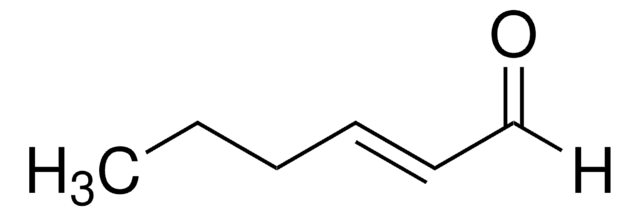W317101
cis-3-Hexenyl acetate
≥98%, stabilized, FCC, FG
Synonym(s):
(3Z)-3-Hexen-1-ol acetate, (3Z)-C-3-Hexenyl acetate, Leaf acetate
About This Item
Fragrance grade
Halal
Kosher
Recommended Products
biological source
synthetic
Quality Level
grade
FG
Fragrance grade
Halal
Kosher
Agency
follows IFRA guidelines
reg. compliance
EU Regulation 1223/2009
EU Regulation 1334/2008 & 178/2002
FCC
Assay
≥98%
contains
α-tocopherol, synthetic as stabilizer
refractive index
n20/D 1.427 (lit.)
bp
75-76 °C/23 mmHg (lit.)
density
0.897 g/mL at 25 °C (lit.)
application(s)
flavors and fragrances
Documentation
see Safety & Documentation for available documents
food allergen
no known allergens
fragrance allergen
no known allergens
Organoleptic
fresh; green; fruity; sweet
SMILES string
[H]\C(CC)=C(/[H])CCOC(C)=O
InChI
1S/C8H14O2/c1-3-4-5-6-7-10-8(2)9/h4-5H,3,6-7H2,1-2H3/b5-4-
InChI key
NPFVOOAXDOBMCE-PLNGDYQASA-N
Looking for similar products? Visit Product Comparison Guide
Related Categories
General description
Application
- Volatiles from cotton aphid (Aphis gossypii) infested plants attract the natural enemy Hippodamia variegata.: This study explored how volatiles, including cis-3-Hexenyl acetate, emitted by cotton plants infested with Aphis gossypii attract the natural predator Hippodamia variegata, highlighting its potential in biological pest control strategies (Yi et al., 2023).
Biochem/physiol Actions
Signal Word
Warning
Hazard Statements
Precautionary Statements
Hazard Classifications
Flam. Liq. 3
Storage Class Code
3 - Flammable liquids
WGK
WGK 2
Flash Point(F)
134.6 °F
Flash Point(C)
57 °C
Personal Protective Equipment
Choose from one of the most recent versions:
Already Own This Product?
Find documentation for the products that you have recently purchased in the Document Library.
Customers Also Viewed
Global Trade Item Number
| SKU | GTIN |
|---|---|
| W317101-1KG | |
| W317101-200G | |
| W317101-1KG-K | 4061837527920 |
| W317101-200G-K | 4061837545986 |
| W317101-5KG | |
| W317101-5KG-K | |
| W317101-SAMPLE | |
| W317101-SAMPLE-K | 4061837527937 |
Our team of scientists has experience in all areas of research including Life Science, Material Science, Chemical Synthesis, Chromatography, Analytical and many others.
Contact Technical Service








